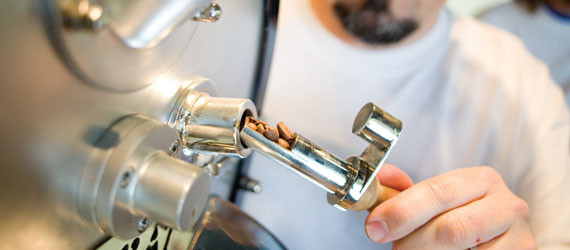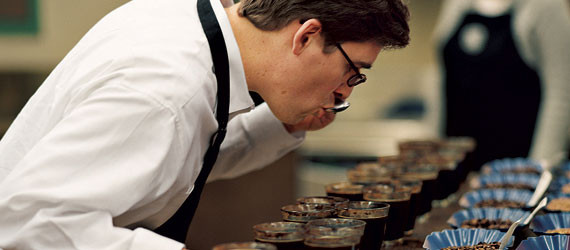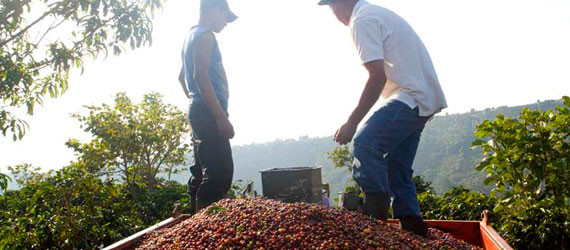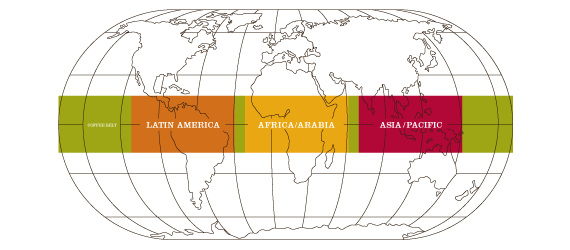The Flavors in Your Cup
A cup of coffee is the end of a long journey – from the land, to the farmer, to the roaster, to your eagerly waiting hands. Each step is important in defining what that coffee will taste like. Walk back along the path with us to see how Starbucks helps make sure a coffee becomes the best cup it can be.


The Starbucks Roast® is more than a color – it’s a philosophy of helping each bean reach its maximum potential.
We started roasting coffee in 1971, and it was the way we approached our craft that created so many Starbucks fans in those early days. Our coffee stood out not only because it was darker, but also because it had more flavor.
Coffee loses moisture and weight when it is roasted, which means there’s less to sell afterwards. A pound of coffee loses about 10 to 14% of its weight when it’s handled by a commercial roaster. We roast our coffee a little longer, to bring out more of the flavor. We lose 18 to 25% of the weight in doing this, but the difference in taste is worth it.
The transformation begins when green coffee beans are heated in a large rotating drum. After 5 to 7 minutes of intense heat, the beans turn a yellow color and smell a little like popcorn. Then the “first pop” occurs – the beans double in size, crackling as they expand. They are now light brown. If you stopped the process here to sample the coffee, you’d taste sour, one-dimensional flavor notes. Those more complex, wonderful flavors haven’t yet developed.
After 10 minutes in the roaster, the beans reach an even brown color, and oil starts to sweat off their surface. Somewhere between 11 and 15 minutes (it’s different for every coffee), the beans start to develop their full flavor potential. The “second pop” signals the moment is at hand. As the beans are released into the cooling tray, the smell of freshly roasted coffee fills the air along with the sound of applause created by the final clapping of the “second pop.”
One of the things we enjoy most about the work we do is bringing you great coffees from around the world.
Some we present as single-origin coffees that showcase particular flavors unique to their birthplaces – we’ll talk about those in a moment. The rest we use to create amazing blends, and that’s what we’ll discuss here.
At Starbucks, we might blend a coffee to showcase a particular growing region. House Blend, for example, combines three great Latin American coffees into one brew that exemplifies the best qualities of that region: lively, clean, well-balanced flavors. Gazebo Blend® highlights African coffees – bright, citrusy and great on ice.
Alternatively, we might blend beans from separate growing regions to weave interesting interplays of aromas and tastes. Blends like Caffè Verona®, Gold Coast Blend® and Starbucks® Christmas Blend, offer complex flavors that can’t be found in single-origin coffees by themselves.


It takes a special bean to become a Starbucks® coffee. We sample over 150,000 cups a year looking for the very best arabica coffees. In the end, only about 3% of the world’s beans makes it into a bag of our coffee.
Starbucks coffee buyers spend about 18 weeks each year visiting coffee growers and suppliers. These relationships are critical to our future success – they solidify our role as champions of quality and progress at every level of the coffee business. It is because of these relationships that Starbucks gets the first pick of some of the world’s best coffee crops. Many of our relationships with farms and suppliers go back more than 20 years.
These relationships are based on mutual respect. In our quest to purchase the best coffee in the world, Starbucks works with farmers to ensure long-term stability within the arabica coffee market. In order for Starbucks to succeed, farmers must succeed as well. See Responsibility to find out more about the way we do business.
As we slurp coffees in our tasting room, we look for the perfect combination of climate, soil, elevation, and agricultural practices that come together to produce a great coffee.
As we taste coffees, the question we ask ourselves is this: Which coffees from a given location best represent the perfect intersection of climate and skilled horticulture? We seek unmistakable regional flavors, what a French wine-maker would call goût de terroir, the “taste of the place.”
Coffees from each of the planet’s three main growing regions have distinctive characteristics:
Latin American coffees tend to be clean, familiar and friendly, with flavors reminiscent of nuts or cocoa.
Coffees from Africa/Arabia are extraordinary and enticing, with floral aromas and flavors of berries and citrus.
Coffees from Asia/Pacific tend to be bold and assertive, full-bodied with earthy and herbal flavors.
Each single-origin coffee we offer exemplifies the best flavor qualities of its region. We invite you to explore a cup.